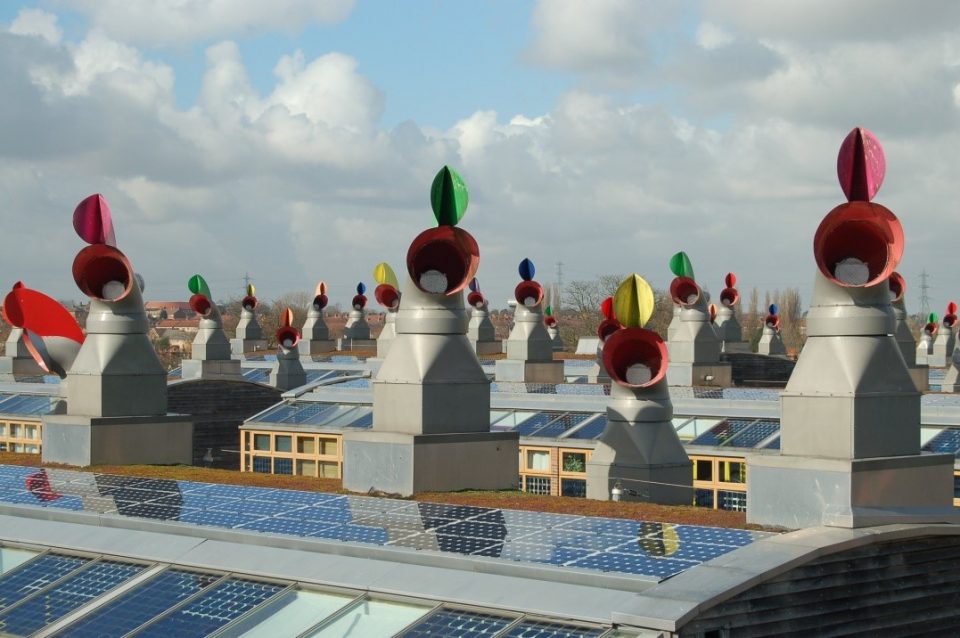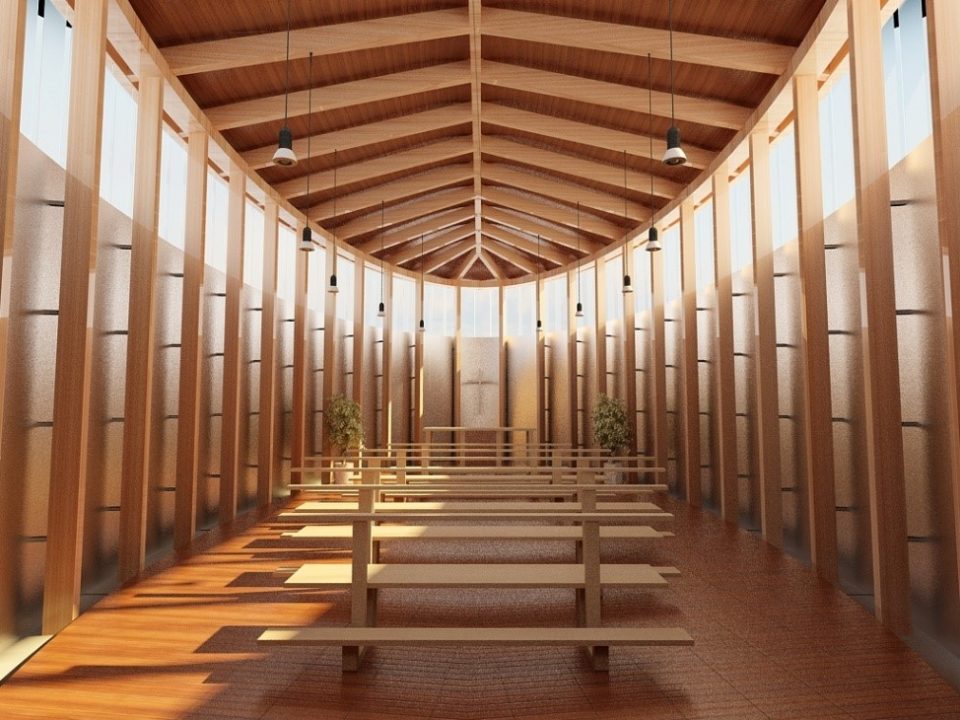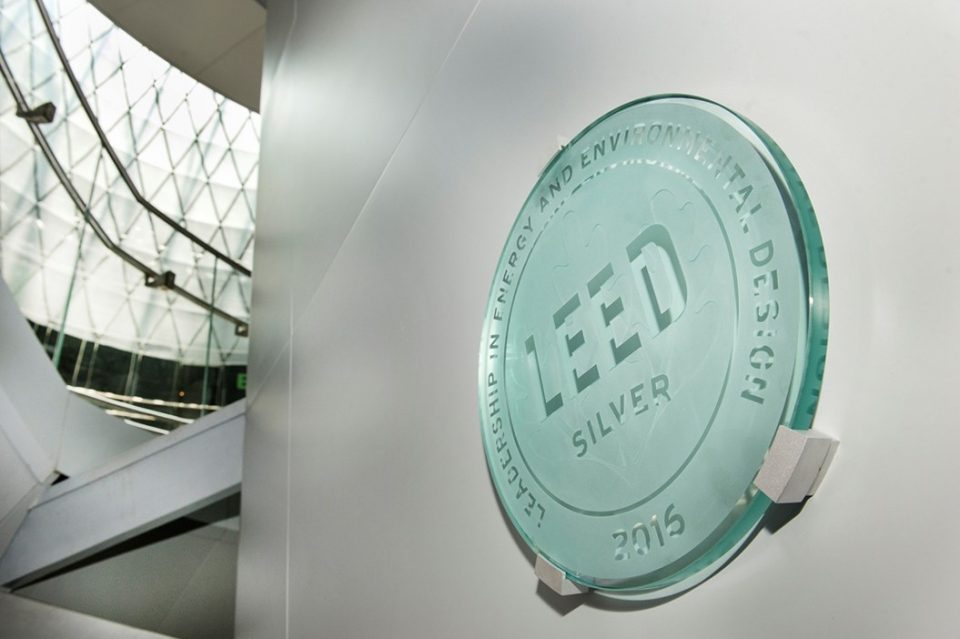What is LEED and why is it important for Interior Designers?
The LEED Green Building Standard was created by the United States Green Building Council (USGBC) in response to a growing problem in design and construction: “greenwashing,” or making claims about the sustainability of a product or a design that are misleading. The value of LEED for Interior Designers is clear is clear: it provides an objective, third-party standard for determining how green a building or interior is – something that will help us all achieve our goals for a healthier planet.

LEED stands for Leadership in Energy and Environmental Design. When we hear “LEED” we are usually thinking about one of two things: it’s either about the design or the designer. Let’s break that down, and talk about greenwashing and brand along the way.
WHEN LEED IS ABOUT THE DESIGN
When we use the LEED standard to talk about a design, a building, a neighborhood, or a city, we use the word “certified” to say that its design has been evaluated according to a number of measures of “greenness,” each of which has a point value. Score enough points and your project can be “LEED certified” or, with more points, LEED Silver, Gold, or Platinum. While LEED has the highest name-recognition of the independent rating systems, it is not the only one, nor was it the first. As the green design movement gained momentum in the 1980s, both in design and consumer products, the temptation to exaggerate the sustainable characteristics of buildings and brands grew, too. Eventually, UL’s (Underwriters Laboratories) codified the problems of “greenwashing.”

SOLVING THE PROBLEM OF HIDDEN TRADE-OFFS AND FIBBING
You may recognize UL as an organization with a mission to protect consumer safety. The sticker on the electrical socket for a light bulb? That’s the UL label. In 2007 they published the 7 Sins of Greenwashing. An example of Sin 1) hidden trade-offs – the product that uses “sustainably harvested” wood but fails to tell you about the toxic resins, glues, and binding agents that lurk in the final product. Sin 2) no proof – we’ve all seen claims that were not backed up with facts. Vagueness (“all-natural” and sometimes “organic” can fall into this slippery category), worshipping false labels, irrelevance, lesser of two evils, and downright fibbing round out the other sins.

OBJECTIVE VERIFICATION OF SUSTAINABILITY
Meanwhile, designers, architects, contractors, manufacturers, and clients were striving to do the right thing but seeing their efforts drowned out by the “noise” of the greenwashers. In the face of this problem, green building rating systems have the potential to support objectively verifiable claims of sustainability. With this in mind, the USGBC was formed in 1993 and published the LEED standard in 1998. It wasn’t the first. Taking a global outlook, we see the United Kingdom’s BREEAM rolled out in 1990; the U.S. Energy Star program was in place by 1992. Nor is LEED the only U.S. standard. The Living Building Challenge focuses on regenerative design, and is endorsed by the USGBC. Green Globes Certification promotes its capacity to be uniquely tailored to a given site.

THE LEED BRAND FAMILY
The USGBC’s LEED is by far the most recognized U.S. ratings brand, and has now grown a family of related standards, each with its own scorecard. There is a standard designed for each, but they share a common assessment system of green strategies organized by category with weighted values and prerequisites. They also share a narrative, visual imagery, and user interface, creating a highly consistent internal ecosystem that differentiates the LEED brand from other rating systems.

LEED AND INTERIOR DESIGN
There are seven LEED scorecard categories (eight, if you include the open-ended “Innovation”). Interior designers often focus on Materials & Resources because this is where recycled and recyclable materials are recognized, but interior design plays a crucial role in the others, especially where VOCs, indoor air quality, daylighting and views are optimized (Environmental Quality); and universal design and accessibility for all are ensured (Sustainable Sites).

WHEN LEED IS ABOUT THE DESIGNER
Certification of design projects is just half the story of LEED. The other half is accreditation of designers. In the language of LEED: “projects are certified, designers are accredited” (see below for an exception to this). LEED Accredited Professionals are those who have demonstrated through examination that they have gained the knowledge to apply LEED standards for a specific rating system, as identified in the LEED brand family. Thus, an interior designer would most often seek to become a LEED AP ID+C (LEED Accredited Professional with a specialty in Interior Design and Construction).
For any of the accreditations, the first step on the path is to become a LEED Green Associate. According to the USGBC, “The LEED Green Associate exam measures general knowledge of green building practices and how to support others working on LEED projects. The exam is ideal for those new to green building.”

For those who have elevated from LEED Green Associate to LEED AP ID+C, there are further opportunities to deepen one’s knowledge through certifications (note this exception to the rule that projects, not people, are “certified”), and to differentiate oneself with badges – 18 of these are available, including knowledge in Occupant Comfort, Material Selection, Carbon, and Health and Wellness.

WHICH CREDENTIAL IS RIGHT FOR YOU?
In building your credentials as an interior design professional, the LEED Green Associate, LEED AP ID+C, and badges are an excellent layer to add on top of two foundational credentials: a CIDA-accredited Bachelor of Fine Arts in Interior Design or a Master of Interior Design; and certification as an interior designer through the NCIDQ process of education, experience, and examination. CIDA-accredited interior design programs teach a range of green design principles including thermal comfort, active and passive solar and ventilation systems, indoor air quality, and criteria for human and environmental well-being.
DESIGN INSTITUTE OF SAN DIEGO
Learn the green design principles successful designers are applying to meet tomorrow’s interior design challenges. Design Institute of San Diego offers a Bachelor of Fine Arts (BFA) in Interior Design Degree Program and a Master of Interior Design (MID) in two and three-year tracks. You’ll learn design fundamentals as well as innovative applications from a faculty of practicing interior designers – and get to experience the profession first-hand as an “extern” at an interior design firm. With a degree from Design Institute of San Diego, you’ll be prepared for a rewarding career in interior design. Learn more.
IMAGE CREDITS
Figure 1 “LEED Gold 2001” by Sam Beebe is marked with CC BY 2.0.
Figure 2 “greenwashing” by elkhiki is marked with CC BY 2.0. “En quoi ce gâteau offert avec un café sauve t’il la forêt vierge équatoriale ? #jplq #greenwashing” by remiforall is marked with CC BY 2.0.
Figure 3 “Wind cowl chatter” by telex4 is marked with CC BY-SA 2.0.
Figure 4 “Where quite a bit of magic happens @USGBC dynamic LEED plaque #MakerdocsDC” by tedeytan is marked with CC BY-SA 2.0.
Figure 5 “Casa del Prado” by author.
Figure 6 “church” by jinkazamah is marked with CC BY 2.0.
Figure 7 “Fulton Center LEED Certification” by MTAPhotos is marked with CC BY 2.0. Figure 8 “Net Zero Home” by Dept of Energy Solar Decathlon is marked with CC PDM 1.0.